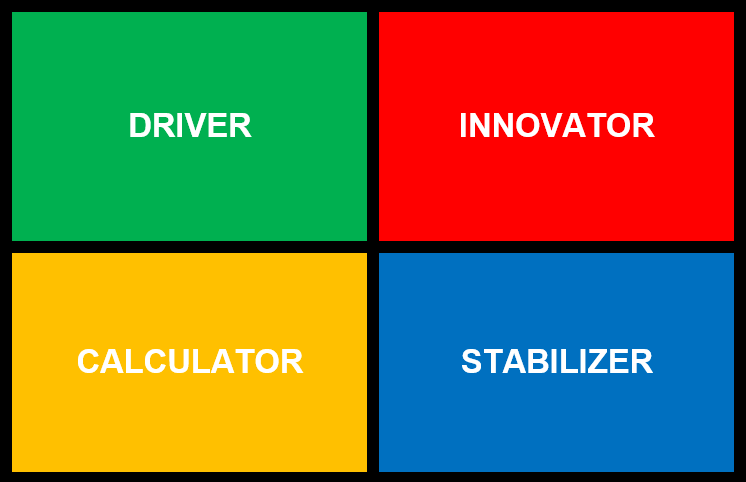Relationship management—whether you’re trying to drive a team forward or train a class of employees, it’s going to come into play sooner or later. Training expert Brad Karsh has four simple categories that will describe many of those you work with, along with advice for understanding the different ways the diverse members of your team might operate.
 |
Karsh, who is president of JB Training Solutions and author of Manager 3.0: A Millennial’s Guide to Rewriting the Rules of Management, shared his tips at the Society for Human Resource Management’s (SHRM) Annual Conference and Exposition held recently in Las Vegas.
Do You Know Who You’re Dealing With?
You (and the members of your team) are going to end up in one of four boxes, says Karsh:

So what are these personality types like? No single one is right or wrong, says Karsh, but they each have their individual super powers—and nemeses. Let’s take a look.
Web-Based Training Courses for Supervisors and Employees: Professionally Developed, Up to Date, Engaging, and Ready to Use! TrainingToday Communicating Effectively at Work Library
The Driver
These people are all about action, says Karsh, and they like to be the chief in any situation. Drivers are direct, efficient, and no-nonsense; they can be demanding (but decisive) and crave structure and order. At their best, they’re who you’d want to be president, says Karsh—they make the tough decisions when they need to be made. At their worst, well … they’re a little bit too demanding.
- Their “holy grail”: Achievement. Drivers want to spend their precious time working, says Karsh.
- Their super power: Making the call.
- Their nemesis: Fools and “feelings.”
The Calculator
It’s all about precision and being the expert when it comes to Calculators, says Karsh. They are cautious, inquisitive, and very into process and/or procedure. Calculators want to take the time to get things right—and they deliver on their commitments. At their best, they’re like a brain surgeon, explains Karsh. They will spend hours exploring every little thing to make sure the surgery goes perfectly; they are not the type to say, “Whoa … that lobe looks a little funny … let’s take it out and see what happens. Chop it off!”
At their worst, says Karsh, Calculators may be too obsessed with precision. Think of the parking authority officer who writes you a ticket for being 18 seconds late.
- Their “holy grail”: Perfection—these workers want to spend their time thinking, Karsh says.
- Their super power: Finding the answer.
- Their nemesis: Mistakes or misdeeds, especially committed by others.
Each course in our extensive TrainingToday Communicating Effectively at Work Library addresses a specific topic with engaging and interactive presentations, delivering practical advice and clear instructions that trainees will remember long after the training is complete. Get the details.
The Innovator
Revisiting Karsh’s brain surgeon analogy, Innovators are the ones who cut out a brain lobe just to see what happens. Innovators are relentlessly energetic, enthusiastic, and optimistic with a “forgive and forget” outlook that often has them gleefully challenging the status quo. It’s all about passion for them.
At their best, Karsh provides the example of the guy who gets up at a wedding because they need someone to make a toast. He makes the guests laugh and cry during an awesome, 8-minute, off-the-cuff speech, and then after he sits down … he admits he doesn’t even know the bride or groom. At their worst, they can be more than a little disorganized.
- Their “holy grail”: Glory! Innovators want to be the star, says Karsh, and they want to ensure they have time to play.
- Their super power: They can swoop in, save the day, and quickly.
- Their nemesis: Those pesky details and deadlines.
The Stabilizer
This tends to be an HR position, says Karsh, because what do Stabilizers love? People! They thrive in the savior role and enjoy helping others out. At their best, Stabilizers are like personal trainers—they’re physically right next to you every step of the way with words of encouragement. At their worst? They can be a bit easy to take advantage of, says Karsh.
Who’s that person in a construction-related traffic jam that lets in the motorist who didn’t realize until the last minute that a lane was closed (who, by the way, is probably an Innovator)? That’s right—the Stabilizer.
- Their “holy grail”: Harmony. They always have (or make) time to listen.
- Their super power: Development of the team.
- Their nemesis: Complaining and complacency.
In tomorrow’s Advisor, more from Karsh on how to manage teams of these diverse personalities, and why the Golden Rule might sometimes not apply.
